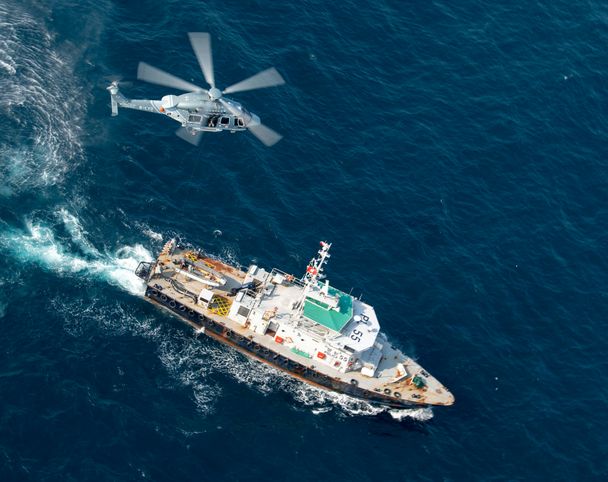Saving lives at the centre of a typhoon: Hong Kong GFS and their H175 fleet have no fear

As the global launch customer of the public service configuration H175, the Hong Kong Government Flying Service (GFS) has operated seven H175 helicopters since receiving the first variant of this configuration in 2018, mainly performing a variety of demanding public service missions such as emergency search and rescue, mountain firefighting and coastal patrol.
In dire straits, the H175 flies to the rescue
In the early morning of 2 July 2022, the floating crane vessel "Fujing 001" was sheltering from Typhoon "Siampa" at an anchorage near Yangjiang, Guangdong Province, China, when its anchor chain broke and it was in distress. The Hong Kong GFS was notified and immediately dispatched three H175 helicopters and one fixed-wing aircraft, a CL605, to the incident site - located 160 nautical miles south-west of Hong Kong - to carry out the search and rescue of the boat’s occupants.
The vessel was located near the centre of the typhoon, with wind speeds up to 144km/h, a low visibility of only 500m and huge waves up to 10m high. On top of that, huge air currents made the flight extremely challenging. According to Captain West Wu, Department Head of the Hong Kong GFS, the most difficult part of the search and rescue operation was the harsh weather and sea conditions.
"A violent storm with extremely strong winds and heavy rain, we were flying against it with an upwind of over 90km/h. It was very challenging for a search and rescue operation," said Wing Li, Captain of the first H175 helicopter that arrived on the scene.

More complications for an already-challenging rescue mission
To make matters worse, in addition to the extreme weather conditions the vessel was located in an offshore wind farm surrounded by over 100 towering windmills, each with a radius of over 100 metres, greatly increasing the difficulties and risks of the search and rescue team.
"The clouds were only about 500 to 600 feet high, while the wind turbines at the wind farm appeared to be at least 800 feet high, and if we flew under the clouds, we could have hit these huge windmills. We had to get inside the clouds and use the onboard radar to find a more open area to descend again."
When arriving at the scene, the team saw that the boat had broken in half and was tilted at about 50-60 degrees. “The sea was rough, the weather was bad and the winds were strong. We soon found three crewmembers on the boat," said Cyrus Szto, a lifeguard aboard the H175 helicopter. "Our winchman and pilot stabilised and then lowered me down. I went to the boat, just near the mast, I clamped my legs around the mast and then used my lifeline to rescue both crew members at the same time. We usually rescue them one by one, but given the dangerous situation, we couldn't wait any longer. I decided to rescue two crewmembers together and put them in the helicopter before I went down and rescued the third person."

The ultra-performing H175
The search and rescue mission was carried out by Airbus Helicopters' new generation of the super-medium H175 helicopter in public service configuration, which has a maximum take-off weight of 7.8 tonnes and 18 standard seats in the passenger cabin. Thanks to Airbus' unique Helionix helicopter-specific avionics system, an advanced dual-redundant, four-axis automatic flight control system, and an advanced search and rescue mode, the H175 helicopter was able to perform winch rescue operations in winds of up to 50 knots omnidirectionally, as well as a steady hover in a horizontal position above the incident point.
With a standard fuel tank capacity of 2,616 litres, the H175 can perform long-range SAR missions at sea without the need for auxiliary fuel tanks, and with a range of up to 250 nautical miles. At a range of 200 nautical miles, up to seven people can be rescued at one time. The H175's spacious sliding door has a wide footrest underneath, which allows the winch operator to stand on the footrest and the rescued person to easily access the cabin. In addition, the H175 is equipped with features such as a cockpit mission display, internally and externally compatible night vision, infrared thermal imaging, search lights and a spacious cabin, which greatly assist in the efficient execution of demanding offshore search and rescue missions.

Hong Kong Government Flying Service - always ready to help
Hong Kong GFS is not only a long-term partner of Airbus Helicopters, but also a role model of global public service operators. As of June 2022, the H175 fleet of GFS has accumulated a total of over 13,000 flight hours. In the last year, the average flight hour per month was over 350 (an average of approximately 12 flight hours per day). This outstanding fleet availability benefits from the high reliability of the H175.
